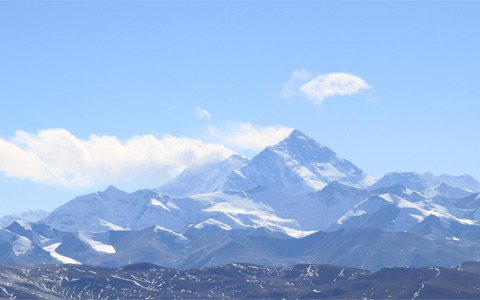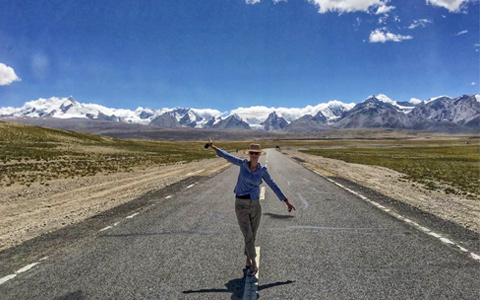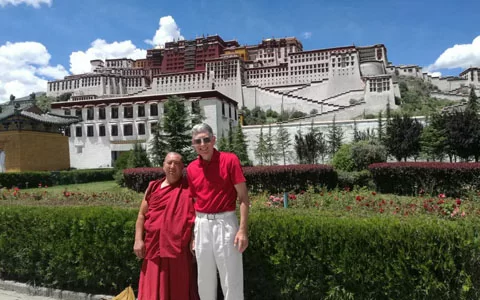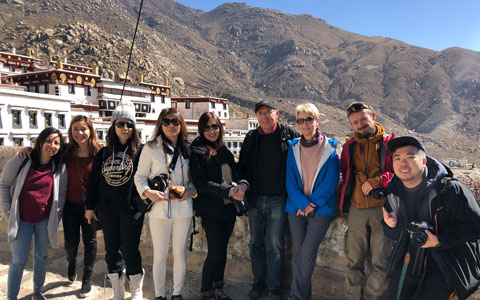10 Most Sacred but Less Visited Tibetan Monasteries
Tibet is renowned for its amazing monasteries, and it is still astounding when you consider there are many of these temples still standing and still in use after almost 1,400 years.
But with so many to choose from, it can be hard to know which you should visit. And some do get a little forgotten among the major monasteries that everyone wants to visit. So here is a list you might like, as the most interesting of the lesser-visited Tibetan monasteries.
 Sakya Monastery - the “Second Dunhuang”
Sakya Monastery - the “Second Dunhuang”
 Rongbuk Monastery - the Highest Monastery in the World
Rongbuk Monastery - the Highest Monastery in the World
 Korjak Monastery - the Most Famous Monastery in Ngari
Korjak Monastery - the Most Famous Monastery in Ngari
 Tholing Monastery - the Oldest Monastery in Ngari
Tholing Monastery - the Oldest Monastery in Ngari
 Tradruk Temple - the First Buddhist Chapel in Tibet
Tradruk Temple - the First Buddhist Chapel in Tibet
 Drak Yerpa - Holiest Caves for Meditation in Lhasa
Drak Yerpa - Holiest Caves for Meditation in Lhasa
 Tsurphu Monastery - Initiation of Reincarnation
Tsurphu Monastery - Initiation of Reincarnation
 Drigung Til Monastery - the Well-known Sky Burial Site in Tibet
Drigung Til Monastery - the Well-known Sky Burial Site in Tibet
 Reting Monastery - Primary Monastery of Kadampa
Reting Monastery - Primary Monastery of Kadampa
 Pabonka Monastery - One of the Most Ancient Buddhist Sites in Lhasa
Pabonka Monastery - One of the Most Ancient Buddhist Sites in Lhasa
Sakya Monastery - the “Second Dunhuang”
Known locally as the “Second Dunhuang”, Sakya Monastery lies in Sa’gya County of Shigatse region, around 127 kilometers west of Shigatse city. Originally built in the 11th century, the old buildings have long since been destroyed, and the main monastery now lies on the southern bank of the Zhingqu River.
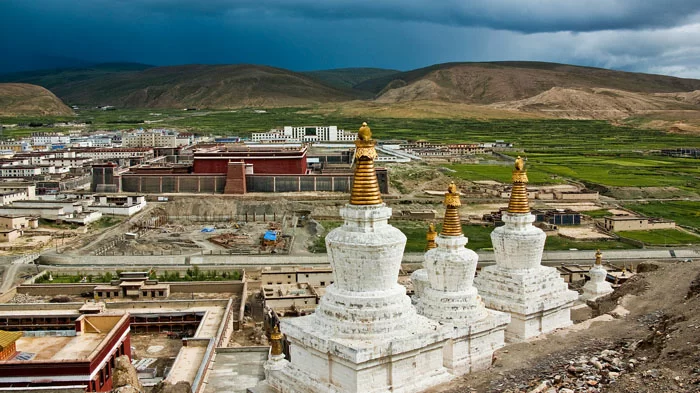 Sakya Monastery the first Sakyapa monastery in Tibet.
Sakya Monastery the first Sakyapa monastery in Tibet.
The monastery is a center of Tibetan culture and literature, and is home to one of the largest collections of precious artworks, not to mention the 3,000-plus ancient Buddhist scrolls that can be found in the monastery library.
The first Sakyapa monastery in Tibet, it was named for the grey soil on which it was built, and gives the same name to the sect of Tibetan Buddhism to which it belongs. Rebuilt on the southern side of the river in 1288 by the 5th Lama of the Sakyapa Sect, the monastery was the seat of power of the rulers of Tibet for 700 years.
Located in the Zhingqu River valley, in Shigatse Prefecture, just 147 kilometers from Shigatse City, and 559 kilometers from the capital of Lhasa, you can get to Shigatse from Lhasa by road or train, as part of a tour in Tibet. The trip to the Sakya Monastery from Shigatse is made by car, as there is no train to the monastery.
Rongbuk Monastery - the Highest Monastery in the World
Renowned as the world’s highest monastery, Rongbuk is a monastery belonging to the Nyingmapa Sect of Tibetan Buddhism, and lies in the Rongbuk Valley, just a short distance from the Everest Base Camp in Tibet.
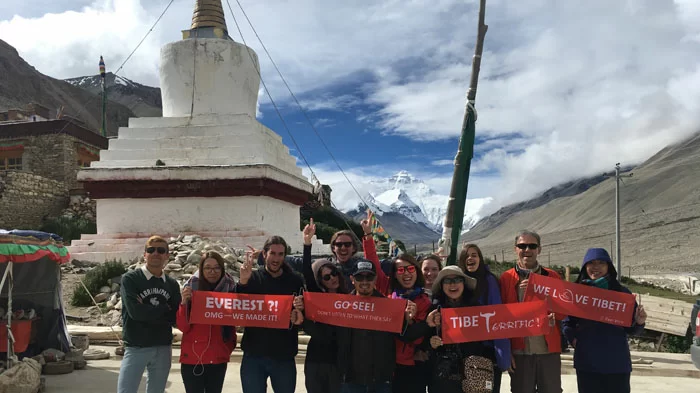 Rongbuk Monastery is near to the Everest Base Camp in Tibet.
Rongbuk Monastery is near to the Everest Base Camp in Tibet.
The monastery was visited by climbers on the way to Mount Everest, and was a base from which to set off for early climbers in the 1920s. The monastery also has one of the best views of the summit of Mount Everest of anywhere in Tibet, and is renowned for the view you can get in the morning as the sun rises and hits the eastern face of the mountain.
Nearby, you can walk along the valley to get a great view of the famous Rongbuk Glacier, and a short way from the monastery, you can actually visit the Everest Base Camp, and even send a postcard home with an Everest stamp.
Getting to Rongbuk Monastery is normally done as part of the classic Everest Base Camp tour, and is done by car from Lhasa. The monastery lies around 4km from the base camp, and is around 597 kilometers from Lhasa.
Korjak Monastery - the Most Famous Monastery in Ngari
A small monastery in Burang County in Ngari Prefecture, Korjak is an important monastery for the Sakya Sect of Tibetan Buddhism, and dates back to around 996 CE. Once an important monastery of the Kagyu sect, the monastery lies close to the Chinese border with India.
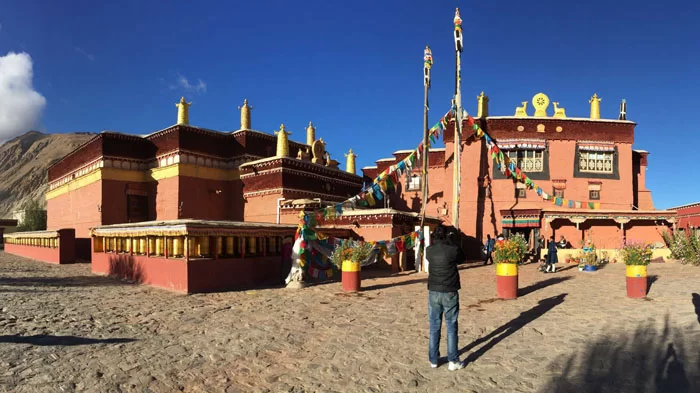 Korjak Monastery is the most famous monastery in Ngari.
Korjak Monastery is the most famous monastery in Ngari.
One of the main highlights of the monastery is the atmospheric main hall, with its vast ancient wooden door, covered in finely detailed carvings. Inside the hall sits the presiding figure of Jampa, the Maitreya Buddha of the Future, and in an ante-room are the ancient paintings from the earliest days of the monastery. And along with the hanging stuffed carcasses of tiger, leopard, bear, wolf, yak, and wolverine, you can follow the inner kora to access a small hidden protector chapel.
The monastery is located in the northwest of Tibet, far from the capital, and is usually visited as part of a longer tour of Tibet, which normally includes Mount Kailash and Lake Manasarovar. Situated around 16 kilometers southeast of Burang Town, it lies some 1,281 kilometers from Lhasa.
Tholing Monastery - the Oldest Monastery in Ngari
The oldest monastery in Ngari Prefecture of Tibet, Tholing Monastery was built in 997 CE by the second king of the ancient and lost Guge Kingdom, Yeshe-O. The name means “hovering in the sky forever”, and the temple consists of three separate temples, which include the Yeshe-O Temple, the Lhakhang Karpo and the Dukhang.
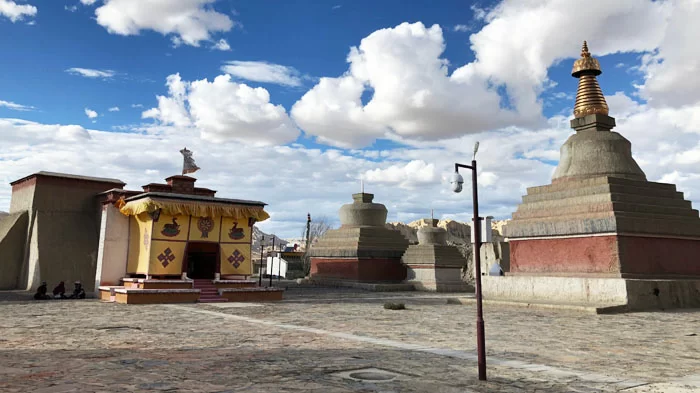 Tholing Monastery is the oldest monastery in Ngari.
Tholing Monastery is the oldest monastery in Ngari.
Replete with ancient and well-preserved frescoes, the monastery was the home of Rinchen Zangpo, a Buddhist text translator of Tantric Buddhism, which he learned in Kashmir. It was Rinchen Zangpo who brought Buddhism to the Guge Kingdom, and for which Tholing Monastery was built. The monastery is also renowned for having been one of the few sites in Tibet that were visited by the great sage, Atiśa.
Located at an altitude of 3,800 meters above sea level in the distant Ngari Prefecture, a short distance northwest of Lake Manasarovar, it is only accessible through a guided tour of Tibet, and is usually reached on a tour from Lhasa to Mt. Kailash and Guge Kingdom, though you can fly into Ngari Airport instead of driving the 1,429 kilometers from Lhasa.
Tradruk Temple - the First Buddhist Chapel in Tibet
One of the earliest Buddhist Monasteries in Tibet, the Tradruk Temple dates back to the 7th century and the reign of Songtsen Gampo, the 33rd Tibetan King. One of seven temples built on the sites of the buried remains of a demoness, the temple is named for the miracle of Songtsen Gampo taking the form of a hawk (tra in Tibetan) to overcome the local dragon (druk in Tibetan), as shown in one of the monastery’s statues.
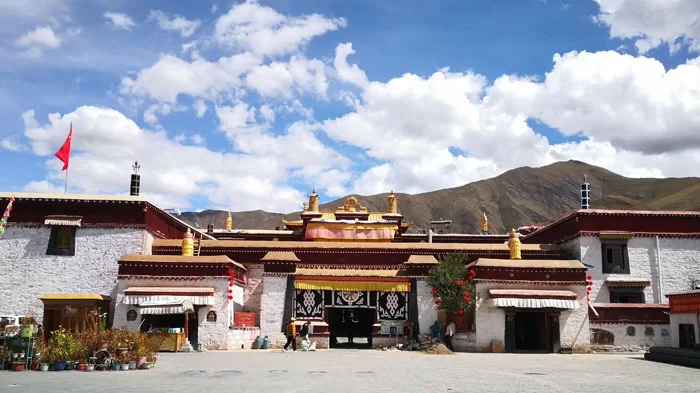 Tradruk Temple is the first Buddhist chapel in Tibet.
Tradruk Temple is the first Buddhist chapel in Tibet.
The main chapel is a huge attraction here, as it holds a statue of the Drolma Sheshema standing next to five of the Dhyani Buddhas. You can also visit the Tuje Lhakhang within the monastery, which contains statues of Chenresig, Jampelyang and China Dorje, the Tibetan Trinity that make up the Rigsum Gompo. And the stove in the Lhakhang is said to have belonged to the Tang Princess, Wencheng, who was the second wife of Songtsen Gampo.
And upstairs in the Lhakhang, you can see the unfurled thangka that depicts one of the Tibetan Trinity, Chenresig, and is made from more than 29,000 natural pearls, which would have been imported from a coastal region to landlocked Tibet to create this amazing piece of art and culture.
Tradruk Temple is located to the southeast of Lhasa, in Tsetang in the Nedong District of Shannan Prefecture, just south of Shannan Town. Travel to the monastery is normally done by car on a tour of Tibet, and takes around 2 hours 30 minutes to traverse the 152km from Lhasa down the Yarlung Tsangpo Valley.
Drak Yerpa - Holiest Caves for Meditation in Lhasa
Renowned for its famous meditation caves, the Drak Yerpa hermitage is one of the holiest cave retreats in Buddhism anywhere in the world. Used for meditation periods by such sage Buddhists as Atiśa, Guru Rinpoche, and Songtsen Gampo himself, the first of the chapels here was established by his Tibetan wife following his sojourn and period of meditation.
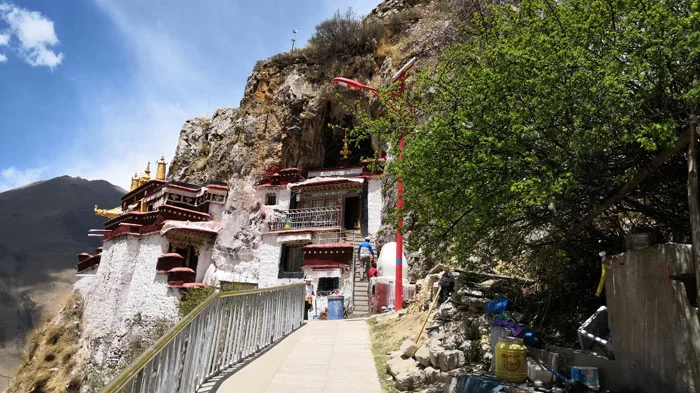 Drak Yerpa is holiest caves for meditation in Lhasa.
Drak Yerpa is holiest caves for meditation in Lhasa.
The nearby Ramoche Monastery once held the summer residence of the Gyuto College, but is now strictly controlled in the number of monks permitted to remain in residence. The biggest attractions are the Rigsum Gompo Cave, the stone “footprints” of Yeshe Tsogyel and the 5th Dalai Lama, and the amazing statues. The Yellow Jamkhang includes an amazing 2-storey statue of the Maitreya Buddha, Jampa, flanked on its sides by the statues of Chana Dorje, Namse, and Tamdrim.
The hermitage contains 108 caves used for meditation, and you can climb up to the Chogyal-puk, the Cave of Songtsen Gampo during his period of meditation. And if you enter the interior chapel, you can admire the thousand-armed statue of Chenresig, which has a continuous stream of pilgrims circling the massive central rock pillar.
The hermitage lies just 32km east of Lhasa, in Dazi County, and can be reached by shuttle bus or by car on an organized tour, and can be visited throughout the year.
Tsurphu Monastery - Initiation of Reincarnation
The main monastery of the local Karmapa branch of the Kagyupa sect of Tibetan Buddhism, Tsurphu was founded by the “Black Hats” in around 1187 by Dusum Khyenpa, and is well known for its long and taxing kora that provides natural springs for refreshment and amazing views of the monastery below and the surrounding mountains.
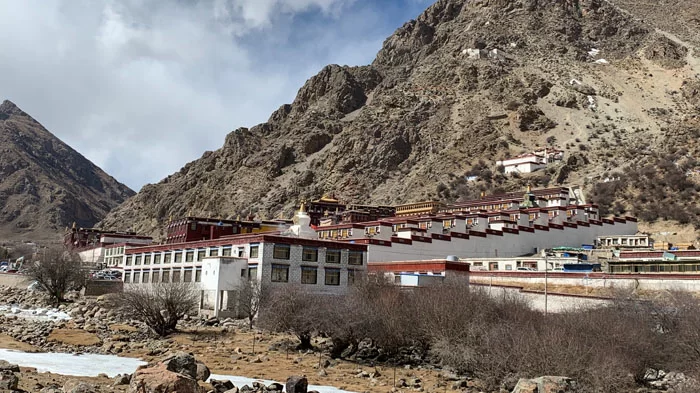 Tsurphu Monastery - Initiation of Reincarnation.
Tsurphu Monastery - Initiation of Reincarnation.
The monastery is also renowned because of its 1st Karmapa, Dusum Khyenpa, who first instigated the concept of reincarnation in Tibetan Buddhist leaders, and is the oldest lineage in Tibet for reincarnated figures.
The kora track takes you out of the monastery, and provides some of the most outstanding views in the region. Rising 150 meters up from the monastery, the kora takes you past springs and shrines to some amazing meditation retreats, up to a beautiful walled garden and on to a sky-burial site, though foreign tourists are not permitted to visit the sky burial site.
Travel to Tsurphu is done by car from Lhasa, which lies to the east, and takes around 2 hours and 30 minutes to travel the 65 kilometers to the monastery.
Drigung Til Monastery - the Well-known Sky Burial Site in Tibet
Built into the sheer face of the cliff, Drigung Til Monastery was once an important monastery of the Kagyu Sect, and was constructed in the 12th century, housing more than 500 monks at its peak.
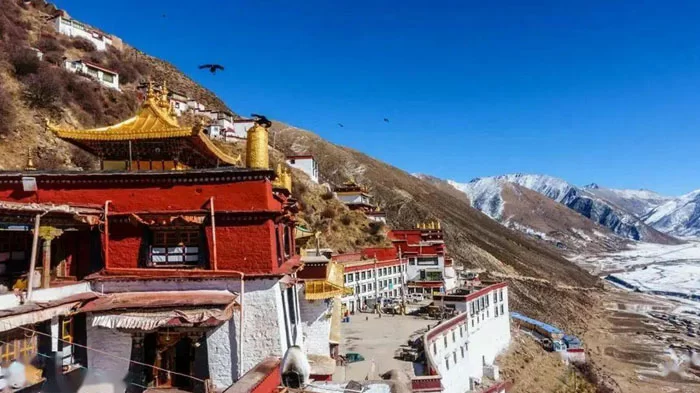 Drigung Til Monastery is the well-known sky burial site in Tibet.
Drigung Til Monastery is the well-known sky burial site in Tibet.
One of the most notorious attractions of Drigung Til is the sky burial site located around 600 meters above the gompa. While tourists are not permitted to watch the gory rituals of dead bodies being chopped up and fed to vultures, it is not uncommon to see a donkey carrying the corpses along the road up to the monastery.
The monastery is also intriguing for its unique location. Built into the side of the mountain cliff, the monastery offers some amazing views over the entire valley, and you can even climb up to the gilded roofs for a better view.
The monastery is located to the northwest of Lhasa in Maizhokunggar County, around 136 kilometers from Lhasa. Travel is only available by car on an organized tour, and it takes more than three hours to get to the monastery.
Reting Monastery - Primary Monastery of Kadampa
Dating back to 1056 CE, Reting Monastery was originally associated with the sage Atiśa, but was later connected with the Gulugpa Sect and the Dalai Lamas, following the appointment of the tutor of the 7th Dalai Lama as the Abbot of the monastery. The seat of the Reting Rinpoche lineage, the monastery became important in the 18th century.
 Reting Monastery is the primary monastery of Kadampa.
Reting Monastery is the primary monastery of Kadampa.
The monastery has some great attractions for travelers, including its main inner shrine, the Utse, which may not be visited by women, and its unusual Jampa Dorje statue which appears to be an amalgamation of the Tibetan Trinity.
The Tsogchen is also the home of an ancient Thangka that is said to have been brought from Bangladesh by Atiśa, and in a small wooden box by the altar, the large molar belonging to Buddha Sangye Wosong, the Buddha who came right before Sakyamuni.
The monastery is located in Tangguo Village, Linzhou County, around 198 kilometers north of Lhasa, and while a shuttle bus does run the 6-hour trip from Lhasa, foreign travelers are required to travel with a tour to visit the gompa.
Pabonka Monastery - One of the Most Ancient Buddhist Sites in Lhasa
Constructed in the 7th century on a flat granite boulder, which is said to resemble a tortoise, Pabonka Monastery pre-dates the Jokhang Temple and was one of the seven temples built to hold down the seven parts of the demoness.
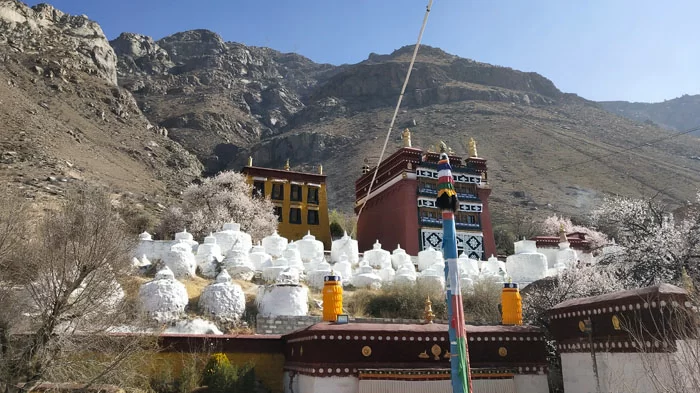 Pabonka Monastery is one of the most ancient Buddhist sites in Lhasa.
Pabonka Monastery is one of the most ancient Buddhist sites in Lhasa.
The monastery is renowned for having seen the patronage and use for meditation of a variety of Tibetan personalities, including King Songtsen Gampo, his wife Princess Wencheng, King Trisong Detsen, and Guru Rinpoche. In the Rigsum Gonpo Temple, you can see the relic of the god-carved 6-part mantra, “om ma ni pad me hum”, which means “hail to the jewel in the lotus”.
In the central shrine lies the 1,300-year-old carving that depicts the Tibetan Rigsum Gonpo Trinity, Chenresig, Jampelyang and Chana Dorje. The carvings are said to be self-arising, in that legend says they grew out of the ground to show this location was to be the site of one of the seven temples.
Located just 8km north of the center of Lhasa, this is one monastery that can be visited without a long journey, and is a popular attraction on Lhasa tours. Just two buses and a taxi will get you there in around 30 minutes.
Conclusion
With many monasteries open to be visited in Tibet, some do get missed out on many tours, despite having amazing histories and outstanding attractions. And getting to the most interesting of these lesser-known and less-visited monasteries can be a great way to explore Tibetan Buddhist culture even deeper.

The Lhasa-born prodigy used to study business overseas, and got his Bachelor of Business in Nepal and India before moving back to his homeland. With pure passion for life and unlimited love for Tibet, Kunga started his guide career as early as 1997.
Responsible, considerate, and humorous, he devoted his entire life to guiding and serving international tourists traveling in Tibet. As a legendary Tibetan travel guru with 20-year pro guide experience. Currently, he is working in Tibet Vista as the Tour Operating Director. Whenever our clients run into trouble, he is your first call and will offer prompt support.
Most Popular Tibet Tour Packages
-

Lhasa - Gyantse - Shigatse - Everest Base Camp - Shigatse - Lhasa
USD939
View Details -

Lhasa - Gyantse - Shigatse - E.B.C - Saga - Kailash Trek - Darchen - Lake Manasarovar - Saga - Gyirong - Tingri - Lhasa
USD2059
View Details -

10 Days Lhasa to Everest Base Camp and Namtso Lake Small Group Tour
Lhasa - Gyantse - Shigatse - EBC - Shigatse - Lhasa - Namtso Lake - Damxung - Lhasa
USD1289
View Details -

8 Days Driving Across Himalaya Overland Adventure from Kathmandu to Lhasa
Kathmandu - Gyirong - Everest Base Camp - Tingri - Shigatse - Gyantse - Lhasa
USD1069
View Details -

4 Days Lhasa Impression Small Group Tour: Explore the Heart of Tibet and Mingle with the Locals
Lhasa
USD509
View Details -

Lhasa - Gyantse - Shigatse - Everest Base Camp - Gyirong - Kathmandu
USD979
View Details -

Lhasa - Gyantse - Shigatse- Lhasa
USD799
View Details -

13 Day Lhasa, Mt. Everest, Mt. Kailash, Lake Manasarovar and Kathmandu Adventure Tour
Lhasa - Gyantse - Shigatse - EBC - Saga - Darchen - Kailash Trek - Darchen - Saga - Gyirong - Kathmandu
USD2059
View Details


.jpg)



